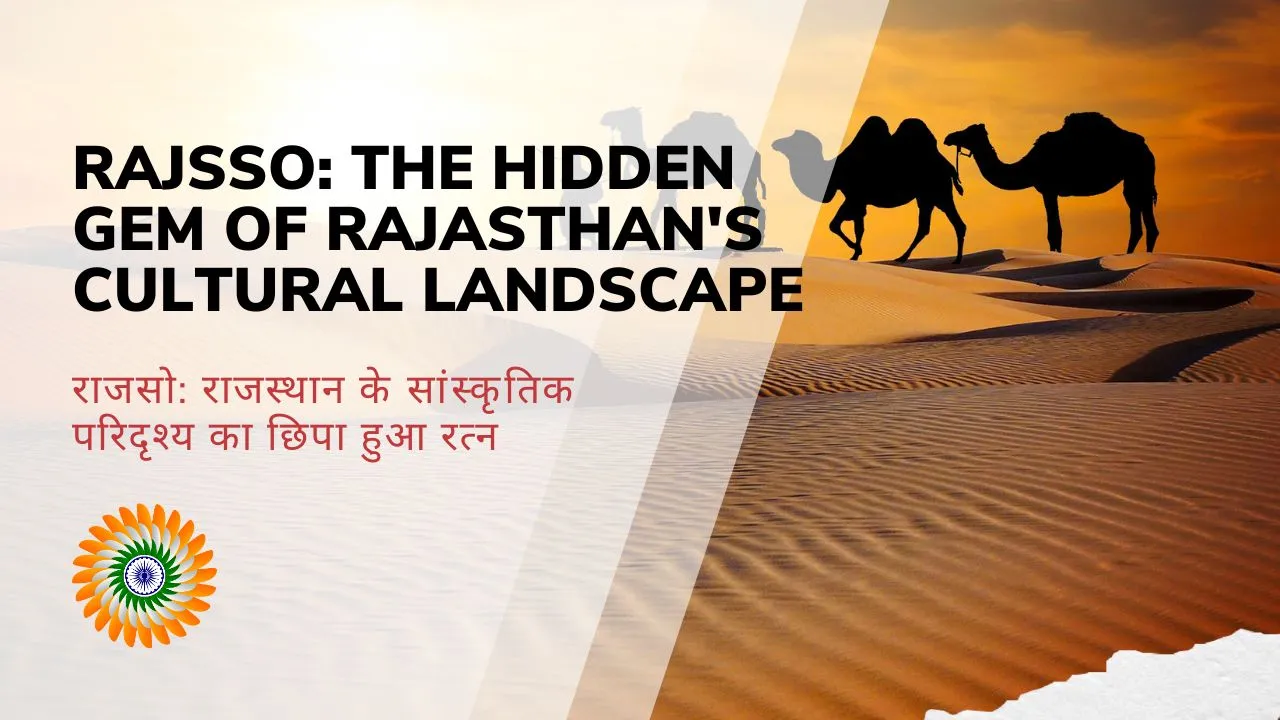Rajsso, a small village in Rajasthan, India, is a place where time seems to stand still. This tiny hamlet, often overlooked by tourists, holds a wealth of cultural treasures and natural beauty. Let’s explore what makes Rajsso special and why it deserves a spot on your travel list.
Where is Rajsso?
Rajsso is tucked away in the heart of Rajasthan, India’s largest state. It sits about 100 kilometers from Jaipur, the state capital. The village is surrounded by sandy dunes and thorny bushes, typical of the Thar Desert landscape.
To get there:
- From Jaipur, take a bus or hire a car
- The journey takes about 2-3 hours
- Roads are mostly good, but get bumpy near the village
The History of Rajsso
Rajsso has a rich past that goes back hundreds of years. The village was founded in the 16th century by a group of Rajput warriors. They chose this spot because of its natural defenses and access to water.
Key historical points:
- Founded: 16th century
- Founders: Rajput warriors
- Purpose: Defense and settlement
Over time, Rajsso grew from a small military outpost to a thriving village. It became known for its skilled craftsmen and farmers. The village played a small but important role in the region’s history, often serving as a rest stop for travelers and traders.
The People of Rajsso
The villagers of Rajsso are known for their warm hospitality and strong community ties. Most families have lived here for generations, passing down their trades and traditions.
The main communities in Rajsso include:
- Rajputs: Descendants of the original founders
- Kumhars: Skilled potters
- Meghwals: Leather workers and weavers
- Jats: Farmers and herders
These groups live together in harmony, each contributing to the village’s unique culture. Visitors often remark on the friendly nature of the locals, who are always eager to share stories about their home.
Click here to read : SSO ID Rajasthan e-Services: Your Gateway to Digital Government Services
Traditional Arts and Crafts
Rajsso is a treasure trove of traditional Rajasthani arts and crafts. The village is especially famous for its pottery and textiles.
Pottery: The Kumhar community of Rajsso creates beautiful clay pots, vases, and figurines. Their work is known for its intricate designs and bright colors. Visitors can often watch potters at work, spinning their wheels and shaping clay with skilled hands.
Textiles: The Meghwal community is renowned for their colorful bandhani (tie-dye) work and embroidery. They create stunning saris, dupattas, and wall hangings using age-old techniques.
Other crafts you can find in Rajsso include:
- Leather work
- Wood carving
- Jewelry making
These crafts not only provide income for the villagers but also keep ancient traditions alive.
Festivals and Celebrations
Life in Rajsso is marked by a series of colorful festivals throughout the year. These events bring the whole community together and offer a glimpse into the rich cultural heritage of Rajasthan.
Some major festivals celebrated in Rajsso include:
- Teej: A monsoon festival celebrating the arrival of rains. Women dress in green and swing on decorated swings.
- Diwali: The festival of lights, marked by clay lamps, fireworks, and sweets.
- Holi: The festival of colors, where people throw colored powder and water at each other.
- Gangaur: A celebration of marital fidelity and the goddess Gauri.
During these festivals, the village comes alive with music, dance, and feasting. Visitors are always welcome to join in the celebrations.
The Natural Beauty of Rajsso
Despite its desert location, Rajsso is surrounded by surprising natural beauty. The landscape changes dramatically with the seasons, offering different experiences throughout the year.
In summer: The heat brings out the hardy nature of the desert flora. You’ll see khejri trees with their wide-spreading canopies providing shade.
During monsoon: The desert blooms with life. Temporary lakes form, attracting migratory birds.
In winter: The crisp air makes it perfect for long walks in the dunes. Sunsets are particularly spectacular during this time.
Nature lovers can enjoy:
- Bird watching
- Desert safaris
- Star gazing in the clear night sky
Traditional Architecture
The houses in Rajsso are excellent examples of traditional Rajasthani architecture. These structures are built to withstand the harsh desert climate.
Key features of Rajsso homes:
- Thick walls: Keep interiors cool
- Small windows: Minimize heat and dust
- Bright colors: Often painted in blues and whites
- Intricate carvings: On doors and windows
The village also has several old havelis (mansions) that once belonged to wealthy merchants. These buildings showcase the finest craftsmanship of their time.
Local Cuisine
No visit to Rajsso is complete without tasting its delicious local food. The cuisine here is typical of Rajasthan – hearty, flavorful, and perfect for the desert climate.
Some must-try dishes:
- Dal Baati Churma: Lentils served with hard wheat rolls and sweetened cereal
- Ker Sangri: A tangy dish made from desert beans and berries
- Gatte ki Sabzi: Chickpea flour dumplings in a spicy yogurt sauce
- Bajre ki Roti: Millet flatbread, a staple in Rajasthani meals
The food is often cooked on traditional clay stoves, giving it a unique smoky flavor.
Folk Music and Dance
Music and dance are an integral part of life in Rajsso. The village has a rich tradition of folk performances that have been passed down through generations.
Popular forms include:
- Ghoomar: A graceful women’s dance performed in flowing skirts
- Kalbelia: Known for its energetic movements, inspired by snake charmers
- Bhopa Bhopi: Storytelling through song, often recounting local legends
In the evenings, it’s common to hear the sounds of dholak (drum) and sarangi (string instrument) floating through the village streets.
Sustainable Tourism Initiatives
Rajsso is taking steps to preserve its culture while benefiting from tourism. The village has started several eco-friendly initiatives to ensure sustainable growth.
These include:
- Homestays: Visitors can stay with local families
- Craft workshops: Learn traditional skills from artisans
- Organic farming: Support local agriculture
- Water conservation: Rainwater harvesting systems
These efforts help preserve Rajsso’s unique character while providing income for the community.
Best Time to Visit
Rajsso can be visited year-round, but some seasons are more comfortable than others.
- October to March: The best time, with cool, pleasant weather
- April to June: Very hot, but good for experiencing desert life
- July to September: Monsoon season, when the landscape is lush
Remember to check the festival calendar to time your visit with local celebrations.
What to Pack
When visiting Rajsso, it’s important to pack wisely. The desert climate can be challenging for unprepared travelers.
Essential items:
- Comfortable, modest clothing: Loose-fitting clothes that cover arms and legs
- Sun protection: Hat, sunglasses, and sunscreen
- Comfortable walking shoes: For exploring the village and dunes
- Reusable water bottle: Stay hydrated in the dry climate
- Camera: To capture the village’s colorful sights
Respect for Local Customs
Visitors to Rajsso should be mindful of local customs and traditions. The village community is conservative and values modesty and respect.
Tips for respectful behavior:
- Dress modestly, covering shoulders and knees
- Ask permission before taking photos of people
- Remove shoes before entering homes or temples
- Use your right hand for eating and greeting
By following these guidelines, you’ll have a more enriching experience and build positive connections with the locals.
Beyond Rajsso: Nearby Attractions
While Rajsso itself offers plenty to see and do, there are several interesting places nearby worth exploring.
- Sambhar Lake: India’s largest inland salt lake, about 60 km away
- Pushkar: Famous for its temples and camel fair, 150 km from Rajsso
- Ajmer: Home to the Dargah Sharif, a major pilgrimage site, 130 km away
- Ranthambore National Park: Known for its tigers, about 200 km from Rajsso
These destinations can easily be combined with a trip to Rajsso for a more comprehensive Rajasthan experience.
Preserving Rajsso’s Heritage
As Rajsso gains recognition, efforts are being made to preserve its unique heritage. Local NGOs and the government are working on projects to document and protect the village’s cultural assets.
Initiatives include:
- Recording oral histories from village elders
- Restoring old buildings
- Promoting traditional crafts in urban markets
- Educating young people about their cultural heritage
These efforts aim to ensure that Rajsso’s rich traditions continue to thrive in the modern world.
The Future of Rajsso
As we look to the future, Rajsso stands at a crossroads. The village faces the challenge of balancing development with preservation of its unique culture.
Key issues include:
- Education: Improving access to quality schooling
- Healthcare: Bringing modern medical facilities to the village
- Infrastructure: Developing roads and utilities without disrupting village life
- Economic opportunities: Creating jobs that allow young people to stay in the village
The community is working hard to address these challenges while maintaining their traditional way of life.
Conclusion
Rajsso may be small, but it offers a rich tapestry of experiences for the curious traveler. From its vibrant arts and crafts to its warm hospitality, this village encapsulates the essence of rural Rajasthan.
A visit to Rajsso is more than just a trip; it’s a journey into the heart of India’s cultural heritage. Whether you’re watching potters at work, savoring local delicacies, or simply chatting with villagers under a starry sky, Rajsso offers memories that will last a lifetime.
So, the next time you plan a trip to Rajasthan, consider stepping off the beaten path to discover the hidden gem that is Rajsso. You’ll find a world where tradition and modernity coexist, where every narrow lane tells a story, and where the spirit of Rajasthan comes alive in its purest form.

